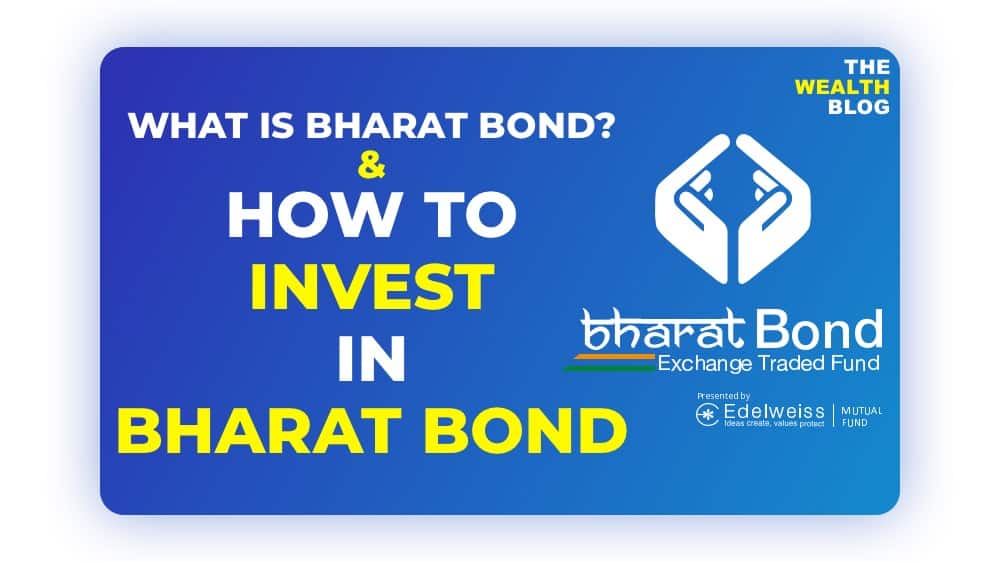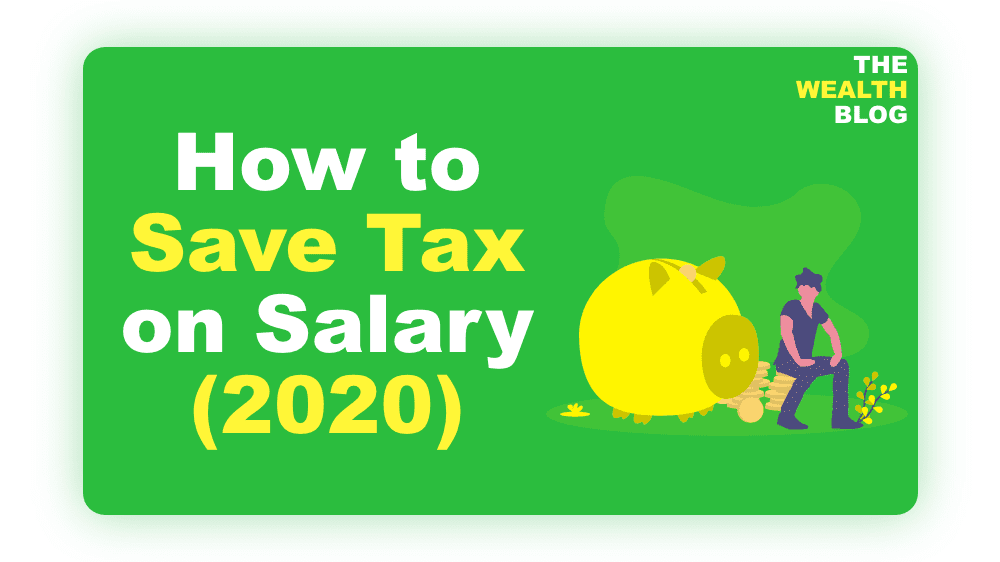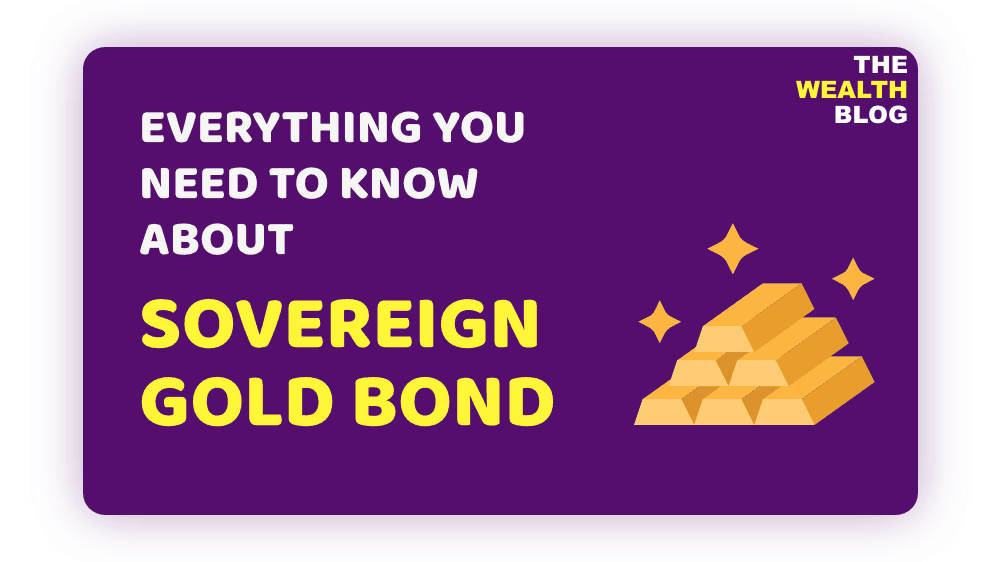
The Wealth Blog Podcast
Government of India Recently Took an Initiative and Launched Bharat Bond ETF.Today We Are Going to See All the Details of Bharat Bond ETF and How to Invest in It.So Let’s Get Started…What Is Bharat Bond ETFFirst of All What Is ETF?ETF Is Exchange Traded Funds. These ETFs Are Traded on Stock Exchanges like NSE and BSE Just like Stocks. ETFs Are Almost like Mutual Funds.Little Confused? Let Me Explain. ETFs Invests Your Money in Basket of Stocks Just like Mutual Funds but unlike Mutual Funds, You Can Trade ETFs on Stock Exchanges. In Simple Words, You Can Call that ETF is a Baby of Mutual Fund and Stock.Bharat Bond ETF Is a Debt ETF Fund. It Is an Initiative by Government of India. It Is Open-Ended and Tracks the Returns Provided by Nifty Bharat Bond Index.Bharat Bond ETF Invests Your Money in “AAA” Rated Public Sector Bonds(for Example, IRFC, NABARD, NHAI, NHPC, NTPC, REC, PFC, Power Grid Corp, and SIDBI).Bharat Bond ETF Has a Fixed Maturity Period.It Follows the Nifty Bharat Bond ETF Index.It Invests in High Quality “AAA” Rated Bonds of Public Sector Companies.It Holds the Bonds till Their Maturity and Reinvests the Coupons Received.It Invests 5% of Its Allocation towards G-SEC/TREPS to Manage Liquidity.Bharat Bond ETF is Managed by Edelweiss Asset Management Limited.Why Invest in BHARAT Bond ETF?Advantages 👍🏻 :Higher Safety: As the Investment Is Done in ‘AAA’ Rated Public Sector Bonds, Risk Is Very Low.
Low Cost: Management Fees of Bharat Bond ETF Is 0.0005% per Annum.No Lock-In: ETFs Are Listed in Stock Exchanges so You Can Buy and Sell Them Anytime.Diversification: This ETF invests in Many Bonds so if any company defaults, the Risk of Losing Investment is very low.Stability and Predictability: A Bond-like Structure with Fixed Maturity Provides Predictable and Stable Returns at MaturityTransparency: Daily Disclosure of Portfolio Constituents and Live Nav Periodically through the DayTaxation:If You Hold This Bond for More than 3 Years Then the Ltcg Tax Will Be Applicable (20%) on Profit but You Will Get Indexation Benefit.If You Hold This Bond for Less than 3 Years Then Stcg Tax Will Be Applicable as per Your Incom Tax Slab.Disadvantages 👎🏻 :Unlike Mutual Funds, to Buy Bharat Bond ETF You Will Need a Demat Account.Liquidity Risk: If You Want to Sell Your Bonds on Stock Exchanges There Can Be Some Liquidity Problems.Bharat Bond ETF ReturnsThere Are ‘NO’ Assured Returns. During the Investment Period, the Value of Investments Can Go Up Or Down Depending on Market Conditions and Are Dependent on Interest Rates Movements in the Economy.However, If You Stay Invested till Maturity of the ETF Then Return Can Be in Line with the Yield of the Portfolio at the Time of Investments.How to Invest in Bharat Bond ETFWe Can Invest in Bharat Bond ETF via 3 Methods.NFO(New Fund Offer) – Minimum Investment – ₹ 1000We Can Invest in the Bharat Bond through the NFO Period. Around 25% of the Subscription Is Reserved for Retail Investors and the Rest 75% Is Reserved for Other Categories of Investors.From Stock Exchanges (NSE)If the NFO Period Is over, We Can Buy and Sell Them during Market Hours. For This, We Will Need a Demat Account.
FOF(Fund of Funds) – No Demat Account Required
In Case You Don’t Have a Demat Account, You Can Invest in Bharat Bond FOF (Fund of Funds).
Conclusion:Okay Okay, Om, I Understood Everything but Just Tell Me, Should I Invest in Bharat Bond ETF or Not?
In My Opinion, If You Want to Diversify Your Portfolio and Planning to Invest in Bond Then You Should Definitely Invest in This Bond.
Otherwise, It’s Not Recommended as You Can Get Better Returns in Other Investments like Index Funds.
Note: Mutual Fund Investments Are Subject To Market Risk, Please Read All Scheme Related Documents Carefully Before Investing.
Visit thewealthblog.in/bharat-bond-etf For Details and Step by Step Guide on How to Apply for Bharat Bond ETF.

Government of india recently took an initiative and launched Bharat Bond ETF.
Today we are going to see all the details of the bharat bond ETF and how to invest in it.
So let’s get started…
Page Contents
What Is Bharat Bond ETF
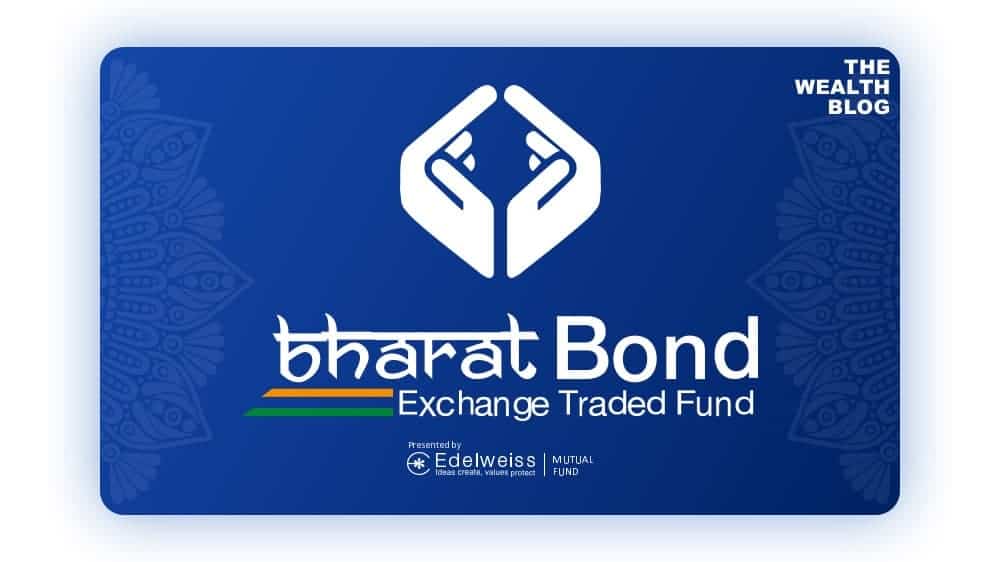
First of All What Is ETF?
Etf is exchange-traded funds. These ETFs are traded on stock exchanges like NSE and BSE just like stocks. ETFs are almost like mutual funds.
Little confused? let me explain. ETFs invests your money in a basket of stocks just like mutual funds but unlike mutual funds, you can trade ETFs on stock exchanges. In simple words, you can call that ETF is a baby of mutual fund and stock.
Bharat bond ETF is a debt ETF fund. It is an initiative by the government of India. It is open-ended and tracks the returns provided by the Nifty Bharat Bond Index.
Bharat bond ETF invests your money in “AAA” rated public sector bonds(for example, IRFC, NABARD, NHAI, NHPC, NTPC, REC, PFC, power grid corp, and SIDBI).
- Bharat Bond ETF Has a Fixed Maturity Period.
- It Follows the Nifty Bharat Bond ETF Index.
- It Invests in High Quality “AAA” Rated Bonds of Public Sector Companies.
- It Holds the Bonds till Their Maturity and Reinvests the Coupons Received.
- It Invests 5% of Its Allocation towards G-SEC/TREPS to Manage Liquidity.
Bharat Bond ETF is Managed by Edelweiss Asset Management Limited.
Comparison with Other Debt Funds and Bonds

Journey of BHARAT Bond ETF
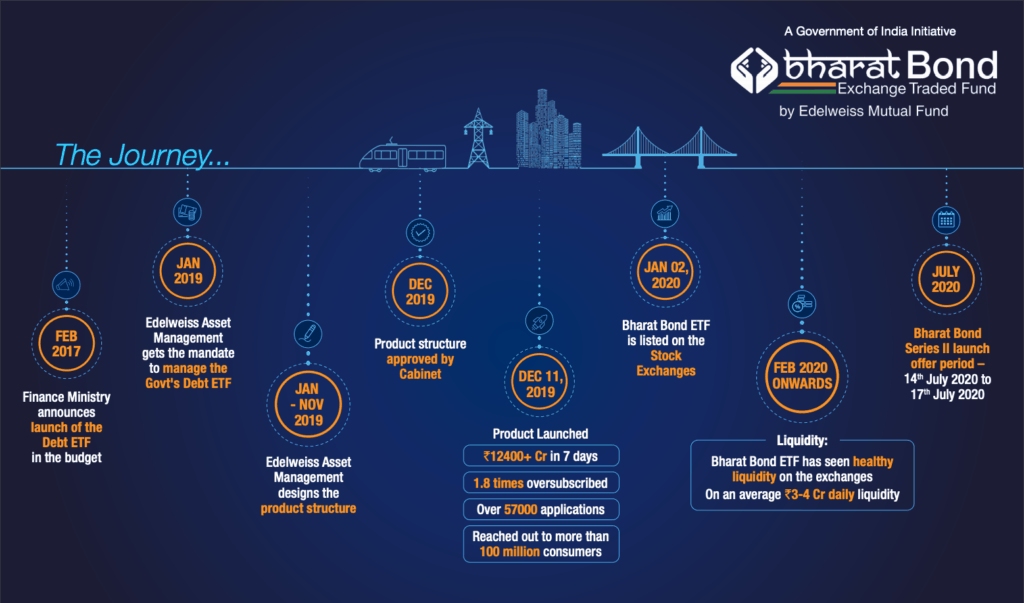
Why Invest in BHARAT Bond ETF?
Advantages 👍🏻 :
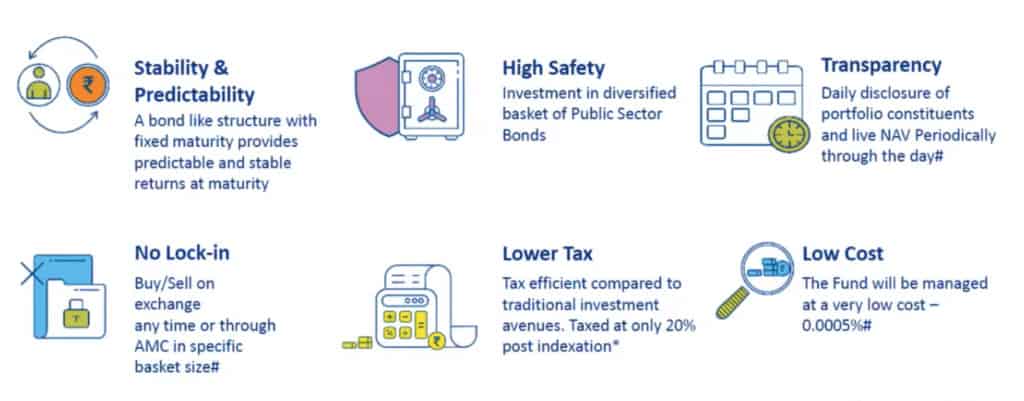
- Higher Safety: As the Investment Is Done in ‘AAA’ Rated Public Sector Bonds, Risk Is Very Low.
- Low Cost: Management Fees of Bharat Bond ETF Is 0.0005% per Annum.
- No Lock-In: ETFs Are Listed in Stock Exchanges so You Can Buy and Sell Them Anytime.
- Diversification: This ETF invests in Many Bonds so if any company defaults, the Risk of Losing Investment is very low.
- Stability and Predictability: A Bond-like Structure with Fixed Maturity Provides Predictable and Stable Returns at Maturity
- Transparency: Daily Disclosure of Portfolio Constituents and Live Nav Periodically through the Day
- Taxation:
- If You Hold This Bond for More than 3 Years Then the Ltcg Tax Will Be Applicable (20%) on Profit but You Will Get Indexation Benefit.
- If You Hold This Bond for Less than 3 Years Then Stcg Tax Will Be Applicable as per Your Incom Tax Slab.
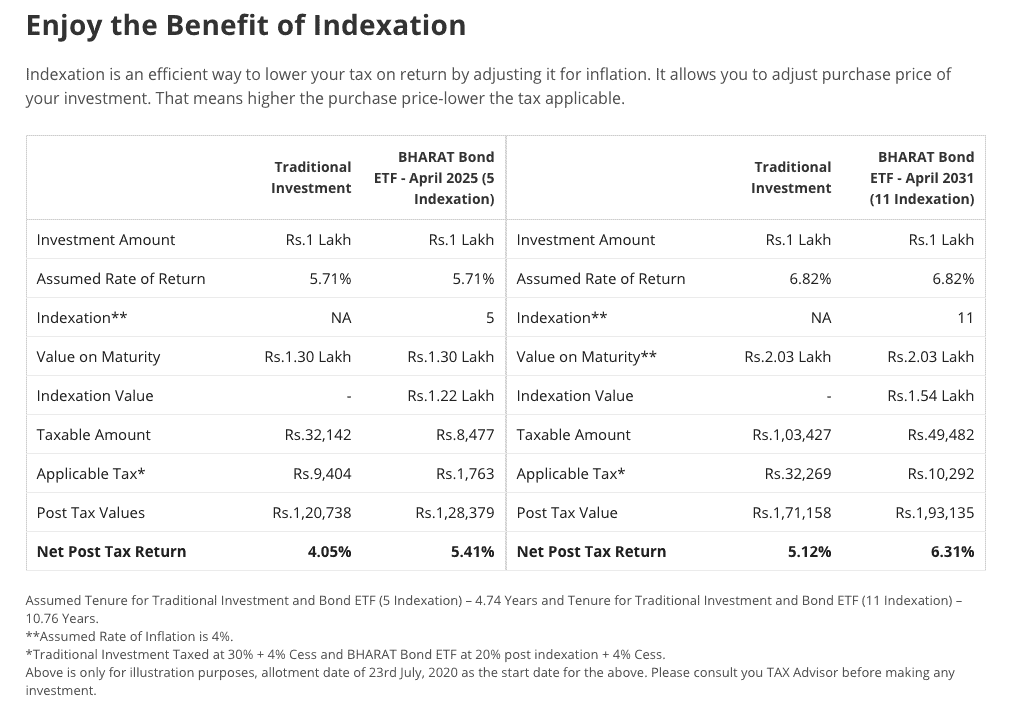
Disadvantages 👎🏻 :
- Unlike Mutual Funds, to Buy Bharat Bond ETF You Will Need a Demat Account.
- Liquidity Risk: If You Want to Sell Your Bonds on Stock Exchanges There Can Be Some Liquidity Problems.
How It Works
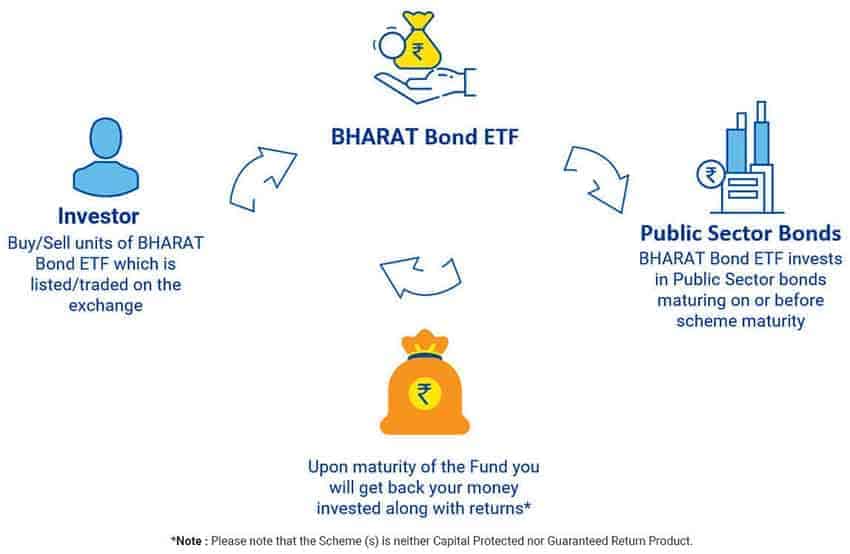
Bharat Bond ETF Details
| Name of the scheme | Bharat Bond ETF |
| Name of the Trustee Company | Edelweiss Trusteeship Company Limited |
| Type of Fund | Open-Ended Target Maturity Exchange Traded Bond Fund That Seeks to Track the Returns Provided by Nifty Bharat Bond Index |
| Investment Objective | To Replicate the Nifty Bharat Bond Index by Investing in Bonds of CPSEs/CPSUs/CPFIs and Other Government Organizations, Subject to Tracking Errors |
| Performance of the Scheme | The Scheme Is a New Scheme and Does Not Have Any Performance Track Record. |
| Minimum Target amount | The Minimum Target Amount to Be Raised during the NFO Period Shall Be ₹20 Crores. |
| Face Value | ₹1000 |
| Expense Ratio | Maximum 0.0005% P.A. Of Daily Net Assets |
| Exit Load for ETF | Nil |
| Listing | Units Will Be Listed on Nse & Bse within 5 Business Days from the Date of Allotment |
| Minimum Amount for Application in the NFO | Anchor Investors: Anchor Investors Can Invest with the Minimum Application Amount of ₹10,00,00,000 (Rupees Ten Crores Only) and in Multiples of ₹1000 Thereafter. Retail Individual Investors: Investors in This Category Can Invest with the Minimum Investment Amount of ₹1000 and in Multiples of ₹1000 Thereafter, Subject to the Maximum Investment Amount of ₹2,00,000(Rupees Two Lakhs Only). Retirement Funds: Investors in This Category Can Invest with a Minimum Investment Amount of ₹201,000 (Rupees Two Lakhs and One Thousand Only) and in Multiples of ₹1000 Thereafter. QIBs: Investors in This Category Can Invest with a Minimum Investment Amount of ₹201,000 (Rupees Two Lakhs and One Thousand Only) and in Multiples of ₹1000 Thereafter. Non-Institutional Investors: Investors in This Category Can Invest with a Minimum Investment Amount of ₹201,000 (Rupees Two Lakhs and One Thousand Only) and in Multiples of ₹1000 Thereafter. |
| Riskometer | Moderate |
| Plans | Growth |
| Fund Manager | Mr Dhawal Dalal (Managing the Scheme Since Inception) Mr Gautam Kaul (Managing the Scheme Since Inception) |
Bharat Bond ETF Returns
There are ‘no’ assured returns. During the investment period, the value of investments can go up or down depending on market conditions and are dependent on interest rates movements in the economy.
However, if you stay invested till the maturity of the etf then the return can be in line with the yield of the portfolio at the time of investments.
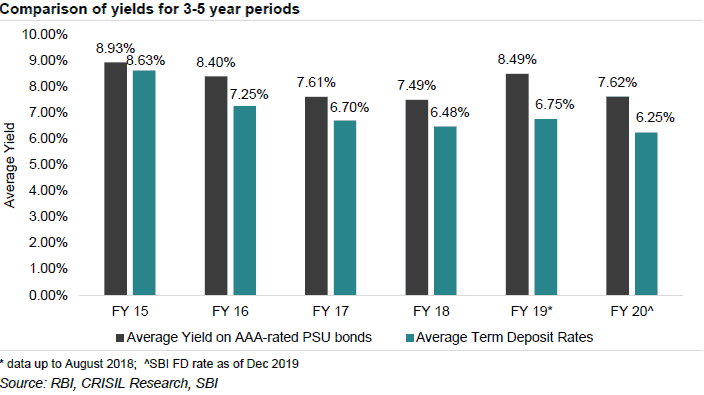
Comparison of Bharat Bond ETF Vs Other Debt Products
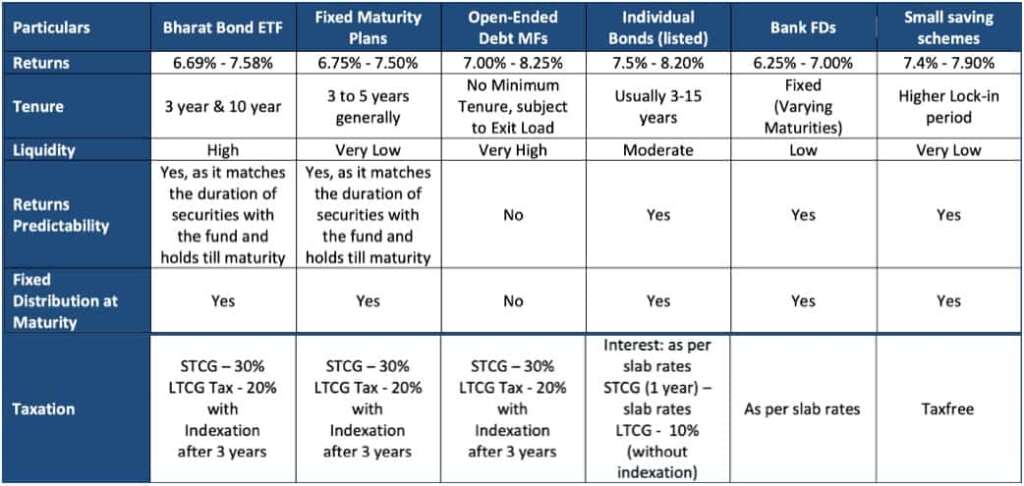
How to Invest in Bharat Bond ETF
We can invest in Bharat bond ETF via 3 methods.
- NFO(New Fund Offer) – Minimum Investment – ₹ 1000
- We Can Invest in the Bharat Bond through the NFO Period. Around 25% of the Subscription Is Reserved for Retail Investors and the Rest 75% Is Reserved for Other Categories of Investors.
- From Stock Exchanges (NSE)
- If the NFO Period Is over, We Can Buy and Sell Them during Market Hours. For This, We Will Need a Demat Account.
- FOF(Fund of Funds) – No Demat Account Required
- In Case You Don’t Have a Demat Account, You Can Invest in Bharat Bond FOF (Fund of Funds).
I’ll add step by step guide when the next NFO will be open for investment. Stay tuned.
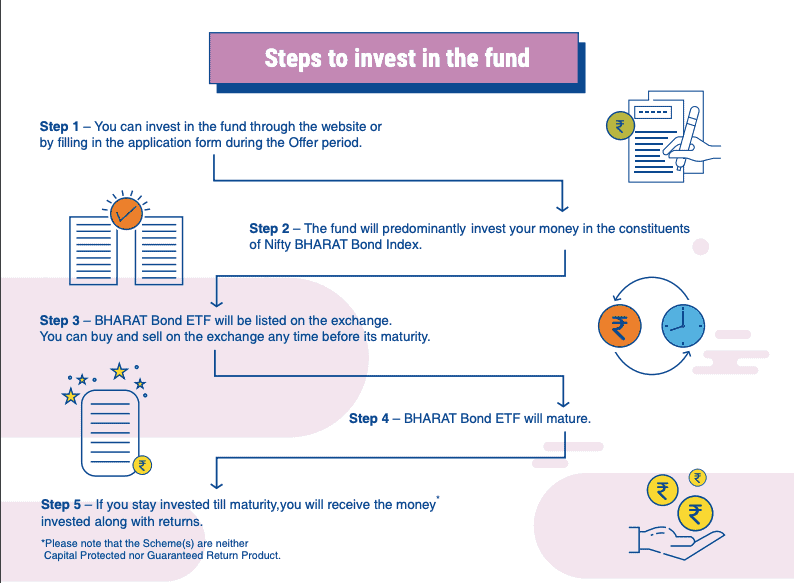
Conclusion:
Okay okay, om, I understood everything but just tell me, should I invest in Bharat bond ETF or not?
In my opinion, if you want to diversify your portfolio and planning to invest in a bond then you should definitely invest in this bond.
Otherwise, it’s not recommended as you can get better returns in other investments like Index Funds.
Note: Mutual Fund Investments Are Subject To Market Risk, Please Read All Scheme Related Documents Carefully Before Investing.
FAQs:
-
Is It Safe to Invest in Bharat Bond ETF?
Bharat Bond ETF Invests Only in the Bonds Issued by CPSEs/CPSUs/CPFIs and Other Government Organizations of u0022AAAu0022 Credit Rating, Such Bonds Have Minimal Credit Risk, Thus It Is Relatively Safe to Invest.
-
What Are the Risks Involved in This Etf?
Investing in Any Fixed-Income Security Has Four Major Risks – Price Risk, Credit Risk, Reinvestment Risk, and Liquidity Risk. u003cbru003eWe Have Mitigated These Risks in the Following Manner: u003cbru003eu003cstrongu003ePrice Risku003c/strongu003e: The Investment Has Target Maturity. This Means the Initial Yield Is Locked If the Investment Is Continued till Maturity. However, If You Withdraw/Redeem Before Maturity, Price Risk Will Remain. u003cbru003eu003cstrongu003eCredit Risku003c/strongu003e: Each Bond Issuer Is a Government of India’s Public Sector Enterprise with a Credit Rating of u0022AAAu0022 Therefore Default Risk, Is Minimal. u003cbru003eu003cstrongu003eReinvestment Risku003c/strongu003e: Coupons/Interest Received by the Fund Are Reinvested in the Similar Underlying Assets as That of the Index/Portfolio. u003cbru003eu003cstrongu003eLiquidity Risku003c/strongu003e: We Have Appointed a Market Maker to Provide Liquidity on the Exchanges (NSE). Hence, You Can Buy/Sell Your Units on the Exchange (NSE) Anytime during Trading Hours.
-
How Easily Can I Withdraw My Funds?
Exchange-Traded Funds (ETF) Are Traded on Exchanges (NSE). It Can Be Purchased and Sold through Your Trading u0026amp; Demat Account like Any Other Traded Securities E.g. Shares, NCDs, Etc. We Have Appointed Market Makers, Who Will Provide Quotes and Liquidity in the Absence of Any Other Market Participants.
-
Is There Any Lock-In Period?
There Is No Lock-In Period. You Can Sell Your Units like You Buy/ Sell Your Shares through Your Trading u0026amp; Demat Account. However, in the Case of FOF, There Is an Exit Load of 0.10% If You Withdraw within 30 Days of Investment. After 30 Days Period, There Is No Exit Load.
-
Are There Any Assured Returns?
There Are No Assured Returns. During the Investment Period, the Value of Your Investments and Hence the Returns on Your Investments Can Go up or Down Depending on Market Conditions and Interest Rates in the Economy.
-
What Are the Different Modes of Payment for ETF?
For Online Investments, Net Banking and UPI Payment Are Two Preferred Modes. For Offline, Please Submit Cheque along with the Application Form. We Also Have an NEFT/RTGS Option for Which You Will Find the Bank Account Details in the Application Form. You Are Requested to Use Your Own Bank Account to Avoid Rejection of Your Application.
-
Who Can Invest in Bharat Bond ETF?
Any Resident (Including NRIs) Individual and Non-individual Can Invest in Bharat Bond ETF. If You Already Have a Demat Account, You Can Apply through Your Trading u0026amp; Demat Account.
-
Is There Any Tax Benefit on Such Investment?
If You Hold Your Investments for More than 3 Years, in ETF or FOF, It Will Qualify for LTCG with Indexation like Any Other Bond Investments. In Comparison, Your Interest Income on Deposits Will Attract the Marginal Rate of Tax (Can Be 30% If You Are in the Highest Bracket).
-
Can NRI invest in Bharat bond?
Any Resident (Including NRIs) Individual and Non-individual Can Invest in Bharat Bond ETF.
